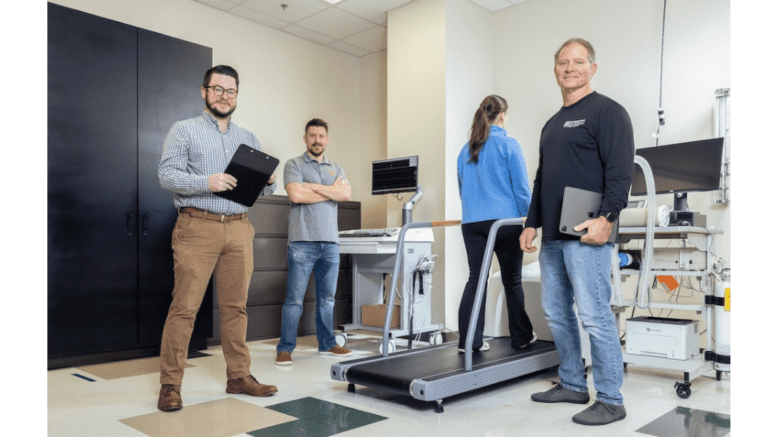Photo above: researchers Austin Brown, Brian Kliszczewicz, and Bob Buresh photographed by Darnell Wilburn Jr.
[This article by Raynard Churchwell first appeared on the Kennesaw State University website, republished with permission]
As our population continues to age, the need for accessible health solutions is more urgent than ever. A recent grant from the National Institutes of Health (NIH) is supporting KSU faculty members, including principal investigator Bob Buresh and co-principal investigators Brian Kliszczewicz and Austin Brown, in investigating how walking can be a transformative and cost-effective approach to fighting obesity.
Brown, a professor of the School of Data Science & Analytics at KSU, has a personal connection to the research. After seeing a family member transform their health through a commitment to walking 10,000 steps a day, the experience influenced his desire to explore walking as an alternative to complex diets and expensive gym memberships.
“What if we could harness the power of something as straightforward as walking?” Brown said. “It’s free, accessible, and has shown promise in preliminary data.”
The research aims to confirm initial findings suggesting that increased step counts correlate with improved health indicators, such as reduced body fat and lower insulin levels. By establishing a model, the team hopes to provide healthcare professionals with a tool to recommend tailored walking goals for their patients.
“Our ultimate goal is to show that walking can be an effective means of controlling various health markers without the complications of traditional methods,” Brown said.
The study will unfold in two phases: first, tracking participants’ normal walking for eight weeks, and then prescribing daily walking goals to assess the predictive model’s accuracy. Collaboration is key, with Buresh and Kliszczewicz contributing expertise in exercise science, while Brown focuses on data quality and statistical analysis.
The team is also receiving valuable support from Kennesaw State’s College of Computing and Software Engineering, which is helping develop the tools needed to gather and analyze the data.
Buresh discussed what made him want to be a part of the study.
“Two-thirds of adults are overweight or obese, and many struggle with weight and cardiometabolic risk management,” Buresh said. “There are potentially millions of people who could be helped by knowing just how active they need to be to prevent weight gain, and/or to lose weight.”
A unique aspect of this study is its inclusivity. By focusing on participants across various age groups and health backgrounds, the team aims to develop a generalized model that can benefit diverse populations.
Brown emphasizes the importance of understanding how different demographic groups respond to walking as an intervention.
“Obesity rates are climbing across all demographics,” he says. “We want our model to be useful for everyone, regardless of age or health status.”
The anticipated outcomes extend beyond physical health metrics. Brown expects that walking may create mental health benefits, including improved sleep quality and reduced anxiety. While the study will primarily focus on physical indicators, the team will also consider participants’ overall well-being.
Once proven, the predictive model could revolutionize patient care. Instead of prescribing rigorous exercise routines or medications, healthcare professionals might recommend achievable daily step goals. This approach will likely resonate with patients who struggle financially.
Looking ahead, Brown envisions expanding the research to address specific populations with unique health needs.
“We want to refine our model to cater to groups that may benefit from tailored recommendations,” he said.
As they gather data and build their model, Brown and his colleagues remain hopeful that their findings will pave the way for healthier lives across the nation one step at a time.
“This research is a prime example of how simple interventions, like walking, can have an impact on public health,” Kliszczewicz said. “I’m excited to contribute to a study that could not only change the way we approach fitness but also improve the quality of life for so many people.”
